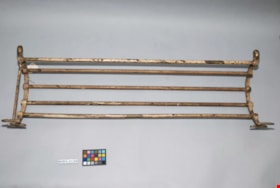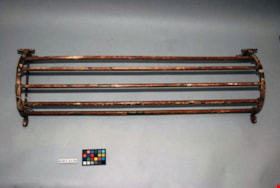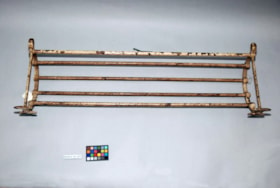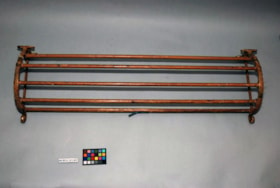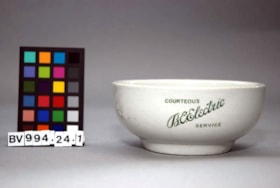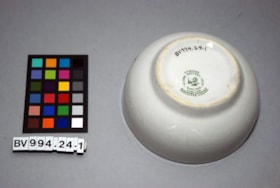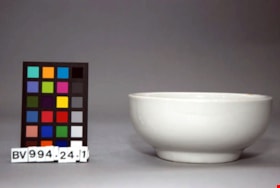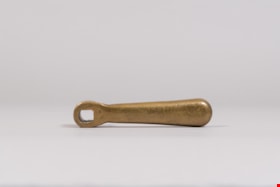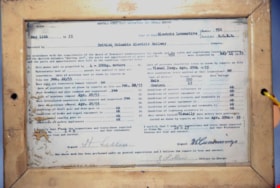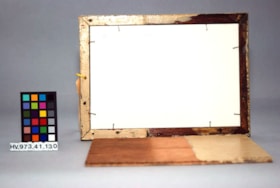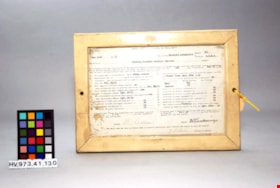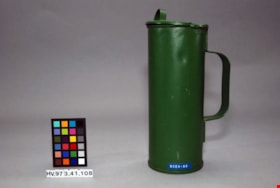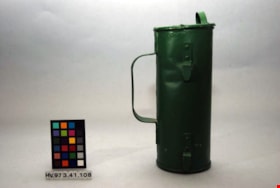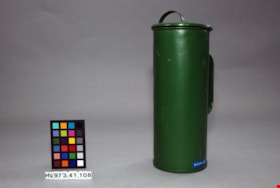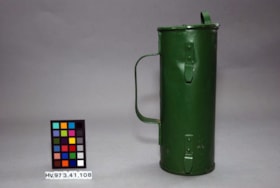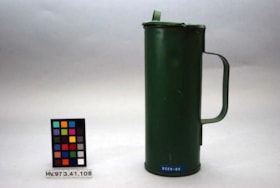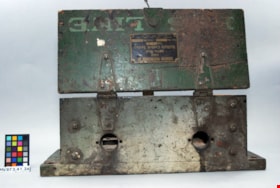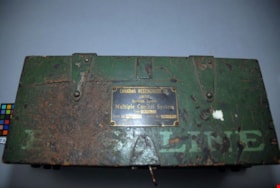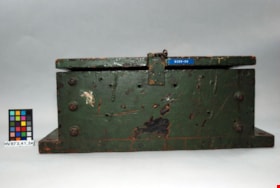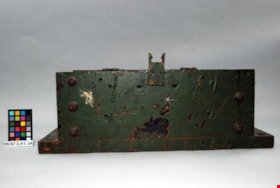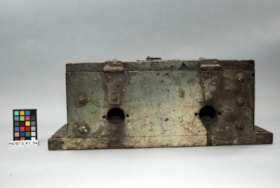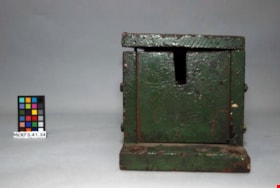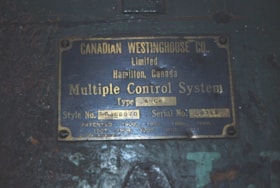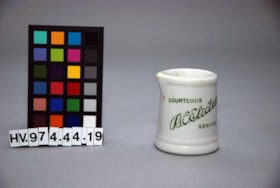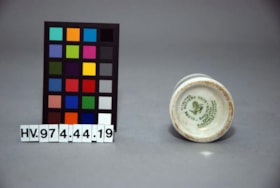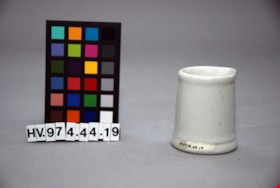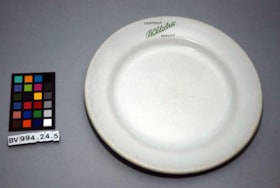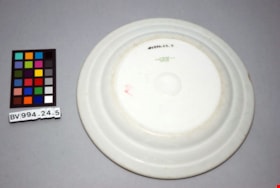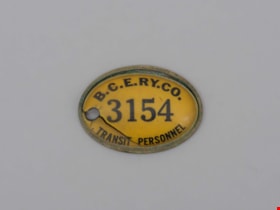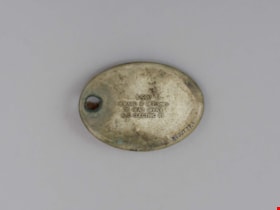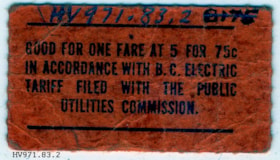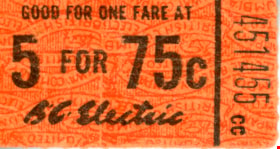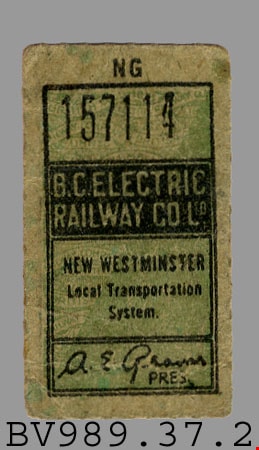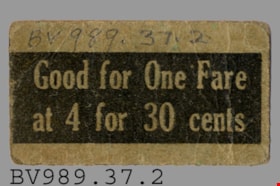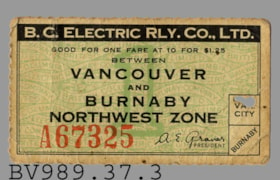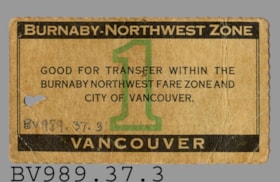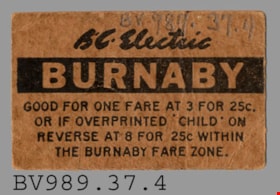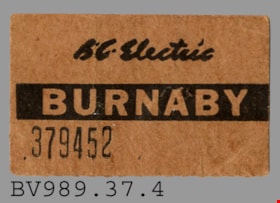Narrow Results By
Subject
- Advertising Medium 14
- Advertising Medium - Signs and Signboards 13
- Building Components 1
- Building Components - Windows 1
- Buildings - Heritage 1
- Buildings - Residential 1
- Buildings - Residential - Houses 1
- Clothing - Headwear 1
- Clothing - Outerwear 2
- Clothing - Uniforms 3
- Container 3
- Container - Box 1
Person / Organization
- Allen, James Charles 1
- British Columbia Electric Railway 3
- British Columbia Electric Railway Company 91
- Burnaby Village Museum 2
- Carson, Norman Thomas "Tom" 2
- Central Park Provincial Park Board 1
- Ceperley, Grace 1
- Ceperley, H.T. 1
- Fripp, Robert Mackay 1
- Gibson, George Selkirk 1
- Irvine, Tom 1
- Lyon, Robert 1
baggage rack
https://search.heritageburnaby.ca/link/museumartifact29010
- Repository
- Burnaby Village Museum
- Accession Code
- HV973.41.86
- Description
- Composed of solid cast brass painted cream, previously green with rear mounting brackets at each end with four holes. There are also curls at the front end for possibly a cord to pass through. Five longitudinal rods forming a basket shape are mounted between the two C shaped end supports which contain the mounting brackets. One end cross member rod is missing. Length: 88 cm Width: 26.8 cm Depth: 14 cm
- Object History
- From British Columbia Electric Railway Interurban #1208.
Images
baggage rack
https://search.heritageburnaby.ca/link/museumartifact29011
- Repository
- Burnaby Village Museum
- Accession Code
- HV973.41.87
- Description
- Composed of solid cast brass painted cream, previously green, with rear mounting brackets at each end with four holes. There are also curls at the front end for possibly a cord to pass through. Five longitudinal rods forming a basket shape are mounted between the two C shaped end supports which contain the mounting brackets. Length: 88 cm Width: 26.8 cm Depth: 14 cm
- Object History
- From British Columbia Electric Railway interurban #1208.
- Marks/Labels
- Blue tape "BCER 1208 - B66".
Images
BCER Eburne Line
https://search.heritageburnaby.ca/link/landmark771
- Repository
- Burnaby Heritage Planning
- Associated Dates
- 1909
- Heritage Value
- In 1908, construction began on the British Columbia Electric Railway Eburne tramline which was to connect Eburne (now known as Marpole) with New Westminster. It opened on September 15, 1909 and its tracks were built across the bog of the Fraser Arm district with little regard to the fact that virtually no one lived there. However, within one year an hourly passenger service, a milk train and three-times weekly freight service used this level fast-running connector. With the completion of the Chilliwack interurban line and various other steam railroads which were funnelled onto this line it became one of the most important industrial freight lines in the Lower Mainland.
- Historic Neighbourhood
- Fraser Arm (Historic Neighbourhood)
- Planning Study Area
- Big Bend Area
Images
bowl
https://search.heritageburnaby.ca/link/museumartifact36104
- Repository
- Burnaby Village Museum
- Accession Code
- BV994.24.1
- Description
- Bowl. White, ceramic, green transfer print on the front of the bowl.
- Object History
- The major B.C.E.R. Main Terminal building at Carrall Street and West Hastings Street in Vancouver and the New Westminster Station at 8th and Columbia included diners where food was served on dishware stamped with the B.C. Electric Railway name.
- Marks/Labels
- On front in green "COURTEOUS" "B.C. Electric" "SERVICE". On underside, "VITRIFIED", in a circle "GLOBE POTTERY CO. LTD. SHELTON" with a lion logo in the middle. Under logo is "ENGLAND" "BUSCOMBE & COMPANY" "VANCOUVER, CANADA."
- Subjects
- Transportation
- Transportation - Public Transit
- Transportation - Electric Railroads
- Food Service Tools and Equipment
Images
Brass handle (key)
https://search.heritageburnaby.ca/link/museumartifact28964
- Repository
- Burnaby Village Museum
- Accession Code
- HV973.41.40
- Description
- A brass handle which has a vertical sleeve at the end with a tapered square hole in it. On the underside is cast in smaller type " C-7414" although the last "4" is suspect. Stamped in the same location is larger type "C 8173".
- Object History
- Used as a key for a street car controller handle. This key was used to activate the street car and moved up or down make it go backwards or forwards. The tram could not move without its key.
- Measurements
- Length: 11.5 cm Width: 2.2 cm Height: 2.3 cm
Images
Central Park Entrance Gate
https://search.heritageburnaby.ca/link/landmark544
- Repository
- Burnaby Heritage Planning
- Description
- The Central Park Entrance Gate is the ceremonial entrance to Burnaby’s historic Central Park from Kingsway, and consists of two massive stone pillars, approximately 7.5 metres high and 1.8 metres square, adjacent gate posts and a low flanking stone wall that curves into the park to the east.
- Associated Dates
- 1913
- Formal Recognition
- Heritage Designation, Community Heritage Register
- Street View URL
- Google Maps Street View
- Repository
- Burnaby Heritage Planning
- Geographic Access
- Imperial Street
- Associated Dates
- 1913
- Formal Recognition
- Heritage Designation, Community Heritage Register
- Enactment Type
- Bylaw No. 9807
- Enactment Date
- 23/11/1992
- Description
- The Central Park Entrance Gate is the ceremonial entrance to Burnaby’s historic Central Park from Kingsway, and consists of two massive stone pillars, approximately 7.5 metres high and 1.8 metres square, adjacent gate posts and a low flanking stone wall that curves into the park to the east.
- Heritage Value
- The Central Park Entrance Gate is significant as a ceremonial entry to a major park, for its connection with the early history of the British Columbia Electric Railway (BCER) and as an important design by an accomplished British Columbian architect. When the original interurban line between Vancouver and New Westminster was constructed in 1891, one of the first stations was located where the tramway crossed the Vancouver-Westminster Road (now Kingsway) within the newly-created Central Park. The interurban line ran through the park on a diagonal right-of-way (the current SkyTrain line, opened in 1986, follows this original alignment). In 1912 an agreement was reached between the successor interurban company, the BCER, and the Central Park Provincial Park Board, to deed additional land for an expanded right-of-way through the Park in exchange for improvements that included the construction of an ornamental stone wall and gate with an iron arch, with an illuminated 'Central Park' sign, adjacent to the interurban station on Kingsway. This was an early and rare example of an electric sign used for a public recreation facility. The Gate is also significant as a surviving early design by Robert Lyon (1879-1963), an Edinburgh-born and trained immigrant who was one of the most accomplished of British Columbia's early architects. After he moved to Vancouver, he was employed by the BCER from 1911 until 1918, and worked on a broad range of projects including some of the grandest and most innovative local industrial structures of the time. The arch was built by the Westminster Ironworks Company, one of the leading firms of its kind in Western Canada, operated by John Reid of New Westminster. The Gate was completed in 1914; in 1968 the decorative ironwork was removed due to corrosion and placed in storage.
- Defining Elements
- Key elements that define the heritage character of the Central Park Entrance Gate include its: - two subtly tapered massive stone pillars, which rise in stages from a larger base to a shaft with random coursed multi-coloured granite with roughly formed grey granite quoins, to a top formed of finely finished grey granite blocks with a coved and bracketed cap - adjacent gate posts with monolithic pyramidal granite caps - low flanking stone wall that curves into the park to the east, constructed of random coursed multi-coloured granite with a river rock triangular cap
- Historic Neighbourhood
- Central Park (Historic Neighbourhood)
- Planning Study Area
- Maywood Area
- Architect
- Robert Lyon
- Builder
- John Reid
- Westminster Iron Works Co.
- Function
- Primary Current--Park Fixture
- Primary Historic--Park Fixture
- Community
- Burnaby
- Cadastral Identifier
- P.I.D. No. 017-767-172 Legal Description: Block B of Lot 2 Except Firstly: Part on Plan 8669 and Secondly: Part on Plan LMP4689 District Lot 151, Group 1, New Westminster District, Plan 3443
- Boundaries
- The property (Central Park) is a municipally-owned park that lies at the western edge of Burnaby, between 49th Avenue to the south, Kingsway to the north, Boundary Road to the west and Patterson Avenue to the east.
- Area
- 853,403.82
- Contributing Resource
- Structure
- Landscape Feature
- Ownership
- Public (local)
- Names
- Lyon, Robert
- Reid, John
- Westminster Iron Works Company
- British Columbia Electric Railway Company
- Central Park Provincial Park Board
- Subjects
- Structures - Fences
- Street Address
- 3883 Imperial Street
- Street View URL
- Google Maps Street View
Images
Certificate holder
https://search.heritageburnaby.ca/link/museumartifact29054
- Repository
- Burnaby Village Museum
- Accession Code
- HV973.41.130
- Description
- A wooden frame containing a report printed on paper. A spare backing board accompanies the frame. The frame is painted a cream colour and has a hole on each side. At the top of the certificate is "MONTHLY POWER UNIT INSPECTION AND REPAIR REPORT" with the number "40256" on the left. The report is for a BCER electric locomotive Number 992 dated May 11, 1955. There are 17 entries which are filled in for the report. Length: 27.4 cm Width: 19.7 cm Thickness: 1.7 cm
- Object History
- Report is very detailed covering 17 items and is certified by three individuals. Report is dated May 11, 1955 and pertains to the Electric Locomotive number 992.
- Marks/Labels
- Collector's previous number "BCER 991-B41".
- Subjects
- Transportation
- Transportation - Public Transit
- Transportation - Electric Railroads
- Documentary Artifacts
- Documentary Artifacts - Reports
Images
Container
https://search.heritageburnaby.ca/link/museumartifact29032
- Repository
- Burnaby Village Museum
- Accession Code
- HV973.41.108
- Description
- A metallic, magnetic cylindrical container painted green with a side handle, hinged top with handle and two mounting brackets riveted to the side. The interior is galvanized, tarnished sheet metal. A blue tape is glued to the front bottom with printing "BCER-B81". Diameter: 9.1 cm Height: 23.1 cm
- Object History
- British Columbia Electric Railway.
- Marks/Labels
- Collectors previous number "BCER-B8" on blue tape.
- Subjects
- Transportation
- Transportation - Public Transit
- Transportation - Electric Railroads
- Container
Images
control box (buss line)
https://search.heritageburnaby.ca/link/museumartifact28958
- Repository
- Burnaby Village Museum
- Accession Code
- HV973.41.34
- Description
- A green wooden box which mounted inside the header of an interurban or streetcar. On the front is a brass plate painted black with "CANADIAN WESTINGHOUSE CO." "Multiple Control System" "Patented 1900 1911". Has a hinged top with a spring loaded clasp at the front bottom. Two flanges extend on both sides of the box with four large holes at each corner for mounting. Five bolts in total (three at one end and two at the end with the slot) extend from the front to the back at each end to hold the box together. A slot is located at one end. At the top are two 4 cm holes allowing for the entrance and exit of electrical cables. Inside are the remains of one of the copper contacts. Length: 50 cm Width: 18 cm Height: 20.1 cm
- Object History
- British Columbia Electric Railway line box "Multiple Control System, West Co."
- Marks/Labels
- "BCER - 58" on blue tape. Metal plate on box lid "CANADIAN WESTINGHOUSE CO. / Limited / Hamilton, Canada / Multiple Control System / Type 496c / Style No.S.O.456070 Serial No. 56713 / PATENTED. 1900, 1902, 1905, 1906 / 1907 1908, 1909, 1910, 1911 / 2709 18-22-1...", etched into the metal plate on box lid. Black background with raised text.
Images
creamer
https://search.heritageburnaby.ca/link/museumartifact26675
- Repository
- Burnaby Village Museum
- Accession Code
- HV974.44.19
- Description
- Creamer. White, ceramic, creamer. Green transfer print on front face
- Object History
- The major B.C.E.R. Main Terminal building at Carrall Street and West Hastings Street in Vancouver and the New Westminster Station at 8th and Columbia included diners where food was served on dishware stamped with the B.C. Electric Railway name.
- Marks/Labels
- On front face is "COURTEOUS" "B.C. Electric" "SERVICE". On underside in green is "VITRIFIED" then a lion logo with "GLOBE POTTERY Co. Ltd. SHELTON" in a circle around logo. Under logo is "ENGLAND" "BUSCOMBE & COMPANY" "VANCOUVER, CANADA.".
- Subjects
- Transportation
- Transportation - Public Transit
- Transportation - Electric Railroads
- Food Service Tools and Equipment
Images
dinner plate
https://search.heritageburnaby.ca/link/museumartifact36108
- Repository
- Burnaby Village Museum
- Accession Code
- BV994.24.5
- Description
- Plate. White, ceramic, dinner size, plate. Green transfer print on rim.
- Object History
- The major B.C.E.R. Main Terminal building at Carrall Street and West Hastings Street in Vancouver and the New Westminster Station at 8th and Columbia included diners where food was served on dishware stamped with the B.C. Electric Railway name.
- Marks/Labels
- On rim in green transfer print is "COURTEOUS" "B.C. Electric" "SERVICE". On underside in green, "VITRIFIED" "GLOBE POTTERY CO. LTD." "COBRIDGE" "ENGLAND". "6-29" is stamped in.
- Subjects
- Transportation
- Transportation - Public Transit
- Transportation - Electric Railroads
- Food Service Tools and Equipment
Images
employee badge
https://search.heritageburnaby.ca/link/museumartifact82305
- Repository
- Burnaby Village Museum
- Accession Code
- BV007.27.1
- Description
- Employee badge, "B.C.E.RY.CO. / 3154 / TRANSIT PERSONNEL". Raised oval shape with a flat back. Plastic or similar material. Obverse is yellow with black lettering, reverse is finished with a silvery plating. There is a punched hole on the left side of the badge. Badge is dirty and yellow is faded. The obverse is split from the hole on the left towards the middle of the bottom edge. Reverse is coroded.
- Object History
- Badge was the property of donor's father who was a conductor on interurban 1223.
- Category
- 08. Communication Artifacts
- Classification
- Personal Gear
- Object Term
- Badge, Identification
- Marks/Labels
- "B.C.E.RY.CO. / 3154 / TRANSIT PERSONNEL" printed on obverse. "$500 / REWARD IF RETURNED / TO HEAD OFFICE / B.C. ELECTRIC RY." embossed on reverse.
- Subjects
- Transportation - Electric Railroads
Images
George S. & Jessie Haddon House
https://search.heritageburnaby.ca/link/landmark508
- Repository
- Burnaby Heritage Planning
- Description
- The George and Jessie Haddon House is a symmetrical two-storey Dutch Colonial-style house with a side-gambrel roof and shed dormers. It is situated in the Burnaby Lake neighborhood in East Burnaby.
- Associated Dates
- 1922
- Formal Recognition
- Heritage Designation, Community Heritage Register
- Street View URL
- Google Maps Street View
- Repository
- Burnaby Heritage Planning
- Geographic Access
- Buckingham Avenue
- Associated Dates
- 1922
- Formal Recognition
- Heritage Designation, Community Heritage Register
- Enactment Type
- Bylaw No. 12064
- Enactment Date
- 19/06/2006
- Description
- The George and Jessie Haddon House is a symmetrical two-storey Dutch Colonial-style house with a side-gambrel roof and shed dormers. It is situated in the Burnaby Lake neighborhood in East Burnaby.
- Heritage Value
- Built in 1923, the George and Jessie Haddon House is a significant example of the romantic period revival styles that were popular during the period between the two World Wars. These traditionally styled homes reflected ongoing pride in past traditions but also recognized the modern ideals of economy and good design. At the time, houses displayed traditional and readily-identifiable historical styles as a hallmark of good taste. The use of the various Colonial Revival styles had gained new popularity during the 1920s, and this design could have originated in a residential pattern book, which were in wide circulation and used to expedite residential projects. This house displays the typical features of the Dutch Colonial style, imported from the eastern United States and relatively rare on the West Coast. The house originally featured an unusual porte-cochere with tapered supports, that indicated the growing importance of automobiles at the time. The house was built for George Samuel Haddon (1886-1971) and his wife Jessie (née Reade) Haddon, whom he married in 1915. George Haddon, who was born in British Columbia, was a prominent Vancouver figure and served as Secretary of the Vancouver General Hospital. Following Jessie's death, George Haddon was remarried to Alice Margaret Currie (1890-1951). The George and Jessie Haddon House is further valued for its connection with the continued development of the Burnaby Lake neighbourhood in the 1920s. The area was highly desirable to wealthy Vancouver and New Westminster residents because of its scenery, and easy access was provided by the British Columbia Electric Railway 'Burnaby Lake' interurban line, which opened in June 1911. The Haddon House illustrates the evolving nature of regional transportation and the growing communities made possible by increasing options for transportation. The house originally stood on a larger lot, and was relocated in 2006 to allow for subdivision and legal protection. The current owners restored the porte-cochere in 2014.
- Defining Elements
- Key elements that define the heritage character of the George and Jessie Haddon House include its: - location within the Burnaby Lake neighbourhood - residential form, scale and massing as expressed by its two-storey height and gambrel roof with shed dormers - rough-cast stucco cladding - Colonial Revival details such as the symmetrical façade and massing, and side-gambrel roof with shed dormers - additional exterior features such as an interior chimney, exposed purlins and window boxes supported on large projecting brackets - wooden front door with glazed insets - interior features including original staircase, and wooden door and window trim
- Historic Neighbourhood
- Burnaby Lake (Historic Neighbourhood)
- Planning Study Area
- Morley-Buckingham Area
- Builder
- William Dodson
- Function
- Primary Historic--Single Dwelling
- Cadastral Identifier
- P.I.D.026-745-127
- Boundaries
- The George and Jessie Haddon House is comprised of a single residential lot located at 5558 Buckingham Avenue, Burnaby.
- Area
- 1080
- Contributing Resource
- Building
- Ownership
- Private
- Documentation
- City of Burnaby Planning and Building Department, Heritage Site Files
- Street Address
- 5558 Buckingham Avenue
- Street View URL
- Google Maps Street View
Images
Handrail
https://search.heritageburnaby.ca/link/museumartifact29038
- Repository
- Burnaby Village Museum
- Accession Code
- HV973.41.114
- Description
- Round wooden handrail painted brown with a brass mounting bracket on each end. The brackets have four screw holes for mounting. Each end of the handle is attached to the bracket via a copper pin which passes through the handle and bracket. A piece of blue tape on the handle is stamped "BCER 1222 B2".
- Object History
- From British Columbia Electric Railway tram #1222.
- Marks/Labels
- Blue tape "BCER 1222 - B8".
Images
H.T. Ceperley Estate 'Fairacres' Mansion
https://search.heritageburnaby.ca/link/landmark526
- Repository
- Burnaby Heritage Planning
- Description
- 'Fairacres' is a large, two-and-one-half storey estate house in the British Arts and Crafts style, located in Deer Lake Park, with four associated original outbuildings.
- Associated Dates
- 1911
- Formal Recognition
- Heritage Designation, Community Heritage Register
- Other Names
- Henry Tracy & Grace Ceperley Estate
- Burnaby Art Gallery
- Street View URL
- Google Maps Street View
- Repository
- Burnaby Heritage Planning
- Other Names
- Henry Tracy & Grace Ceperley Estate
- Burnaby Art Gallery
- Geographic Access
- Deer Lake Avenue
- Associated Dates
- 1911
- Formal Recognition
- Heritage Designation, Community Heritage Register
- Enactment Type
- Bylaw No. 9807
- Enactment Date
- 23/11/1992
- Description
- 'Fairacres' is a large, two-and-one-half storey estate house in the British Arts and Crafts style, located in Deer Lake Park, with four associated original outbuildings.
- Heritage Value
- 'Fairacres' is important as a record of the early years of Burnaby, specifically the Deer Lake area, as a place of tranquility and beautiful scenery in which the wealthy and successful in the burgeoning cities of New Westminster and Vancouver chose to retire or to make their family homes. The main house, which anchors in style and setting the outbuildings on the estate, demonstrates the social, cultural, and aesthetic values of local wealthy businessmen and women of the early twentieth century - values such as appreciation of architectural elegance and grand interior spaces, leisure and recreation, formal landscaped gardens and scenic views. Also important is the association with the English-born and trained architect Robert Mackay Fripp (1858-1917), as this was one of his grandest residential commissions. Steeped in the current architectural trends in Great Britain, Fripp designed this sprawling mansion in the Arts and Crafts style, reflected in the architectural detailing and proportions. The style was common at the time and was often used for estate mansions as a symbol of affluence and good, modern taste as well as an affinity for all things British. Quality is displayed inside and out in the finishes and materials, orchestrated by prominent local contractor, James Charles Allen, including imported English materials of specific value such as imported Medmenham tiles in the fireplace surrounds, one of the earliest documented use of these tiles outside the United Kingdom. Detailed features of the interior woodwork were carved by Scottish-born master wood carver George Selkirk Gibson (1867-1942), who was best known for his many commissions for prominent British Columbia architect Samuel Maclure. The outbuildings at 'Fairacres' are an important record of the functioning of a large estate of the time. The Garage and Stables and the Chauffeur’s Cottage accommodated the use of automobiles, horses and carriages, and in concert with the estate's location near the new British Columbia Electric Railway 'Burnaby Lake' interurban line, illustrate the evolving nature of regional transportation and the growing bedroom communities and estates made possible by increasing options for transportation. Other outbuildings accommodated the agricultural activities that helped support the Ceperley estate. The estate was conceived and funded by American-born Grace E. Dixon Ceperley (1863-1917), who had achieved significant wealth through a bequest from her brother-in-law, Vancouver pioneer Arthur Ferguson. Her husband, Henry Tracy Ceperley (1850-1929), also American-born, was a successful and well-respected businessman who made a significant contribution to the development of the City of Vancouver. The construction of 'Fairacres' spawned the transformation of the Deer Lake area from a farming community into a preferred location for elite suburban homes. 'Fairacres' is significant to the City of Burnaby as its first civic heritage conservation project. Acquired in 1966 for conversion to Burnaby’s first art gallery, it was dedicated in 1967 to mark Canada’s Centennial of Confederation.
- Defining Elements
- Key elements that define the heritage character of the ‘Fairacres’ mansion include its: - setting in relation to the gardens, its former market garden, and the vistas to Deer Lake and other grand homes in the area - side gable roof with prominent dormers and cedar shingle cladding - verandah across the eastern (garden) facade, with its view over the landscaped gardens and the distant mountains - porte cochere with its side steps for those arriving by automobile, and central raised step for those alighting from horse-drawn carriages - rich variety of exterior elements that demonstrate the typical Arts and Crafts use of local materials such as cobble stone chimneys and foundations, wide wooden siding and half-timbering - mixture of double-hung and casement wooden-sash windows, many with multi-paned sash - lavish interior spaces, designed for entertaining on a grand scale, including a billiard room with a beamed ceiling and an inglenook fireplace, and generous living and dining rooms arranged off a central hall - quality of the interior materials such as imported Medmenham tiles in fireplace surrounds, window hardware by Hope and Sons, and leaded stained glass - interior wood work including the staircase, and carvings by George Selkirk Gibson - remaining formal Edwardian garden landscape elements, including the cross-axial plan that reflects the relationship of the mansion to its 'outdoor rooms'
- Locality
- Deer Lake Park
- Historic Neighbourhood
- Burnaby Lake (Historic Neighbourhood)
- Planning Study Area
- Douglas-Gilpin Area
- Architect
- Robert Mackay Fripp
- Function
- Primary Current--Museum
- Primary Historic--Estate
- Community
- Burnaby
- Cadastral Identifier
- P.I.D. No. 004-493-311 Legal Description: Block 3 Except: Part subdivided by Plan 26865, District Lot 79, Group 1, New Westminster District, Plan 536
- Boundaries
- ‘Fairacres’ is comprised of a single municipally-owned property located at 6344 Deer Lake Avenue, Burnaby.
- Area
- 17,065.00
- Contributing Resource
- Building
- Landscape Feature
- Ownership
- Public (local)
- Other Collection
- City of Burnaby, Visual Art Collection: Original rendering by R.P.S. Twizell Burnaby Historical Society, Community Archives: Ceperley Photograph Album Burnaby Village Museum, Collection: Carved dining room panels by G.S. Gibson and other hardware items
- Documentation
- Heritage Site Files: PC77000 20. City of Burnaby Planning and Building Department, 4949 Canada Way, Burnaby, B.C., V5G 1M2
- Names
- Ceperley, Grace
- Ceperley, H.T.
- Fripp, Robert Mackay
- Allen, James Charles
- Gibson, George Selkirk
- Street Address
- 6344 Deer Lake Avenue
- Street View URL
- Google Maps Street View
Images
interurban ticket
https://search.heritageburnaby.ca/link/museumartifact1610
- Repository
- Burnaby Village Museum
- Accession Code
- HV971.83.2
- Description
- BC Electric Fare - Ticket.
- Subjects
- Exchange Medium
- Exchange Medium - Tickets
Images
interurban ticket
https://search.heritageburnaby.ca/link/museumartifact3334
- Repository
- Burnaby Village Museum
- Accession Code
- BV989.37.2
- Description
- B.C. Electric Railway - Ticket. Small green ticket for the British Columbia Electric Railway Company good for one adult on the New Westminster line. Stamped at the top of the ticket is "157114". The back of the ticket states "Good for One Fare at 4 for 30 cents".
- Object History
- Object was acquired by donor from the estate of his sister-in-law, Jean Low Scott, a long-time Burnaby resident.
- Colour
- Green
- Measurements
- L: 3.5 cm W: 2.0 cm
- Subjects
- Exchange Medium
- Exchange Medium - Tickets
- Transportation
- Transportation - Electric Railroads
Images
interurban ticket
https://search.heritageburnaby.ca/link/museumartifact3335
- Repository
- Burnaby Village Museum
- Accession Code
- BV989.37.3
- Description
- B.C. Electric Railway - Ticket. Buff coloured ticket for the British Columbia Electric Railway Company, good for one adult fare at 10 for $1.25 between Vancouver and Burnaby Northwest Zone. The ticket is stamped on the left side with "A67325". The right corner has a punch through the VanCity box. The reverse side of the ticket restates the information on the front. The ticket measures 5.5cm x 3cm.
- Object History
- Object was acquired by donor from the estate of his sister-in-law, Jean Low Scott, a long-time Burnaby resident.
- Colour
- Beige
- Subjects
- Exchange Medium
- Exchange Medium - Tickets
- Transportation
- Transportation - Electric Railroads
Images
interurban ticket
https://search.heritageburnaby.ca/link/museumartifact3336
- Repository
- Burnaby Village Museum
- Accession Code
- BV989.37.4
- Description
- B.C. Electric Burnaby - Ticket. Brown coloured ticket for the British Columbia Electric Railway in Burnaby. The ticket is good for one Adult's fare at 3 for 25 cents within the the Burnaby fare zone. The ticket states that the fare would be good for a child if the ticket was over printed with "CHILD". Stamped on the front of the ticket is "379452". The ticket measures 3.5cm x 2cm.
- Object History
- Object was acquired by donor from the estate of his sister-in-law, Jean Low Scott, a long-time Burnaby resident.
- Colour
- Brown
- Subjects
- Exchange Medium
- Exchange Medium - Tickets
- Transportation
- Transportation - Electric Railroads
Images
interurban ticket
https://search.heritageburnaby.ca/link/museumartifact3337
- Repository
- Burnaby Village Museum
- Accession Code
- BV989.37.5
- Description
- B.C. Electric Burnaby - Ticket. Brown coloured ticket for the British Columbia Electric Railway in Burnaby. The ticket is good for one Adult's fare at 3 for 25 cents within the the Burnaby fare zone. The ticket states that the fare would be good for a child if the ticket was over printed with "CHILD". Stamped on the front of the ticket is "379452". The ticket measures 3.5cm x 2cm.
- Object History
- Object was acquired by donor from the estate of his sister-in-law, Jean Low Scott, a long-time Burnaby resident.
- Colour
- Brown
- Subjects
- Exchange Medium
- Exchange Medium - Tickets
- Transportation
- Transportation - Electric Railroads
